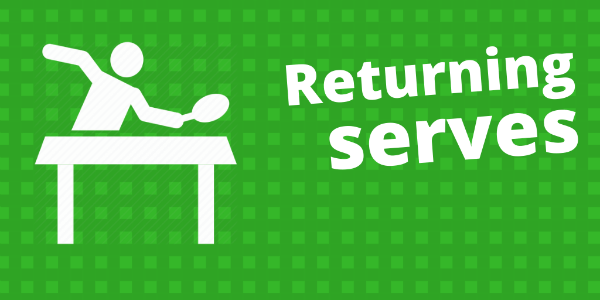Returning serves is hard. It’s the thing most players at the beginner and intermediate levels struggle with the most. It’s easy to understand why. There’s a lot of different spin, speed and placement variations players use when serving. Plus all the different service actions – some short and sharp, others with big exaggerated swings. Returning serves can be very daunting!
But there are ways you can get better at returning serves, even if you have only just started playing table tennis. In this blog post, I give some simple advice about how you can return more serves, plus I share a BIG NO-NO, something you should never do…
“I just can’t return that serve”
Returning serves is the most common thing players ask me about during my coaching sessions.
A player will say to me…
“Joe Bloggs has such an amazing serve. I just can’t return it. Everytime I try to return the serve, the ball flies off the table. I don’t know what to do. Help!”
So we talk about what serve the player struggles with. Then I try my best to replicate the serve. And sure enough, the player cannot return it.
But the issue 9 times out of 10 is not that the serve is amazing. The issue is that the player is prodding at the ball.
What is a prod?
A prod is where a player nervously and cautiously moves the bat slowly to the ball. It’s usually a very short movement, often with a quite a bit of tension. A prod isn’t actually a stroke. It’s nothing. It’s just aimlessly putting your bat in the way of the ball.
So what happens when you prod the ball when returning a serve? Usually, the ball flies off your rubber. This is because all the spin from the serve is dominant. A prod does nothing to control the spin or impart new spin. So whatever spin is on the serve will dictate how the ball comes off your rubber.
- If it’s a backspin serve and you do a prod return, the ball will shoot straight down into the net.
- If it’s a topspin serve and you do a prod return, the ball will shoot up and off the end of the table.
- If it’s a side-backspin serve and you do a prod return, the ball will shoot sideways and down off the side of the table.
- If it’s a side-topspin serve and you do a prod return, the ball will shoot sideways and up off the side of the table.
- If it’s a no spin serve and you do a prod return, it might actually land on the table (hooray!), but it’s not likely to be a very good return of serve!
You have to play a stroke
So in my coaching sessions, I ban prodding. It will never be effective when returning serves. Prodding is not allowed.
I tell my players again and again (until it sinks in), “You have to play a stroke”. You have to control the server’s spin or put your own spin on the ball.
So how do you return serves? Which strokes should you play?
If you really struggle with returning serves, I suggest starting with this simple approach…
- If it’s a backspin serve, you push.
- If it’s a side-backspin serve, you push, but aim more to the middle.
- If it’s a topspin serve, you drive.
- If it’s a topspin serve, you drive, but aim more to the middle.
- If it’s a no-spin serve, you could push or drive. Your choice.
With this approach, you don’t have to worry about which stroke to play, so you can focus much more on reading the service spin (here’s a video about that).
Instead of being fearful when returning serves, you change your mindset and approach it as a positive problem solving challenge. You put all your energy into reading the service spin and then push or drive.
It’s such a simple approach, especially for beginner and intermediate players. In a short period of time many players I coach can go from being hopeless at returning my serves (20% success rate) to returning most of my serves, probably with 70%-80% success rate.
You can topspin too
As you improve, you can even take a more advanced approach and try and topspin or flick most serves, which is quite possible at amateur levels, where serves are often a little too loose (here’s a video about that).
But don’t rush to do this topspin approach. If you are at the beginner / intermediate level, I think it’s probably far better to start with the basic approach of playing a push or a drive. You can return most serves by doing this. It’s easier to do to begin with. And it can really help you focus on watching the server, working out spin, and playing a stroke.
REMEMBER: DO NOT PROD. YOU MUST PLAY A STROKE!
Returning serves – online course
If you would like more help on returning serves, I recommend joining Tom’s TT Academy. I have a 10 lesson in-depth online course all about returning serves. The lessons include…
- Returning backspin serves
- Returning topspin serves
- Returning sidespin serves
- Reading service spin
- Learning from mistakes
- Where to stand when returning serves
- How to apply pressure on your opponent when returning serves
You will also get access to a wide range of coaching content, including
- in-depth courses
- training drills
- fitness videos
- robot training videos
- member discussions
- video analysis
- skill challenges
- coaching clinic
- and lot’s more!
You can access all this content for less than £1 per week. New content is added regularly. Join hundreds of table tennis players around the world today at www.tomsttacademy.com

